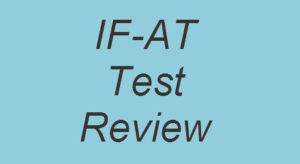Using IF-AT as Part of Exam Review
One of the highlights of the recent ICTCM conference was Eric Mazur’s keynote address about “Assessment For Learning.” He mentioned an assessment technique known as IF-AT (Immediate Feedback Assessment Technique) that reminded me a great deal of the review strategy I have been using in my intermediate algebra course. (Here’s a blog on that review strategy.) I thought it was a great idea to try, so immediately postponed my elementary algebra exams on systems of two linear equations in two unknowns by one day to give this a try. I added a second review day so I can introduce this strategy to my students over a two day period.
The idea is that students work on a series of problems individually. After half of the class period has ended, students submit their individual work and form groups of four students. They then discuss their answers as a team and submit a team answer to the first problem. If they get it right the first time they get full credit. If they get it wrong they can select a second answer to submit for 1/2 credit. They can even try it a third time if needed for 1/4 credit. I saw a video where the problems were in a multiple choice format with 4 possible answers, and the teams were given a scratch off card. A star was displayed on the right answer – if students see the star they know they are right, if they see a blank space that counts as an incorrect attempt.
You can see a step-by-step demonstration of how the IF-AT works
on this web page posted by Epstein Educational Enterprises.
I am going to use a Learning Catalytics Team-Based Assessment to put my spin on this process. On day 1, students will work individually on 8 problems for 30 minutes. Some problems will be conceptual, some will be systems to solve, and there will be two word problems. They will submit their answers as they work. I will then launch the team portion of the assessment. Students will form their own groups of 4, with one person responsible for entering their team answers. I have decided to give teams only two attempts on each problem. A correct answer on the first attempt will receive full credit and a correct answer on the second attempt will receive half credit.
The individual portion will make up half of the score, with the team portion making up the other half of the score. I will be counting the score as an in-class activity in my flipped classroom model. I expect students to take a little time to get used to working with Learning Catalytics, so I have tried to select problems that they will be able to answer in the given time limit. I expect day 2 of the review will be smoother. My students work so well together, and I expect to see their bonding pay off in this review.
Later this week I will let you know how it goes.
Do you have any experience using IF-AT in the classroom? Do you use it for testing? I’m curious how you address students who have testing accommodations through the testing office. Let me know by leaving a comment, reaching me through the contact page on my website, or reaching out to me on Twitter (@georgewoodbury).
-George
